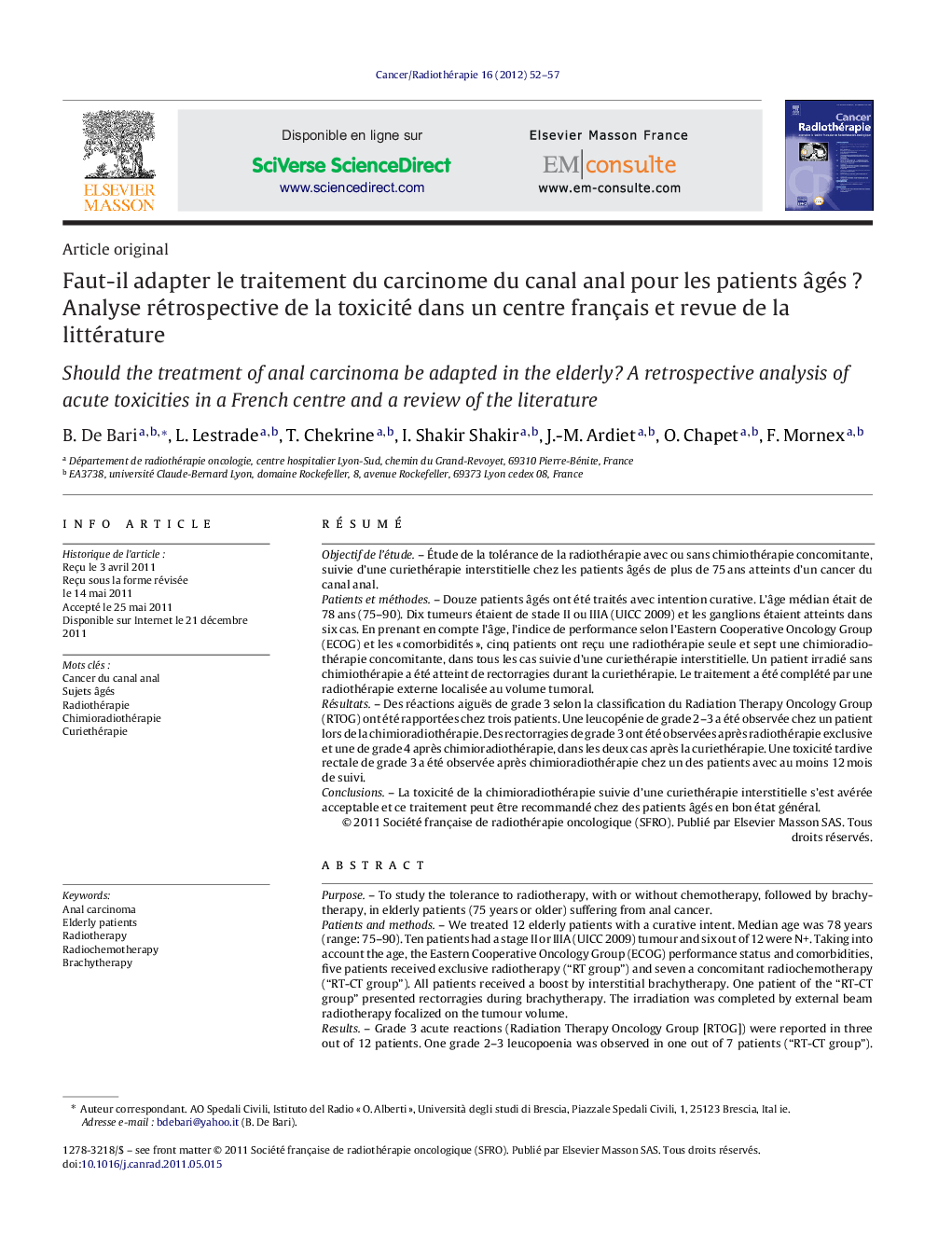| کد مقاله | کد نشریه | سال انتشار | مقاله انگلیسی | نسخه تمام متن |
|---|---|---|---|---|
| 2118318 | 1085230 | 2012 | 6 صفحه PDF | دانلود رایگان |

RésuméObjectif de l’étudeÉtude de la tolérance de la radiothérapie avec ou sans chimiothérapie concomitante, suivie d’une curiethérapie interstitielle chez les patients âgés de plus de 75 ans atteints d’un cancer du canal anal.Patients et méthodesDouze patients âgés ont été traités avec intention curative. L’âge médian était de 78 ans (75–90). Dix tumeurs étaient de stade II ou IIIA (UICC 2009) et les ganglions étaient atteints dans six cas. En prenant en compte l’âge, l’indice de performance selon l’Eastern Cooperative Oncology Group (ECOG) et les « comorbidités », cinq patients ont reçu une radiothérapie seule et sept une chimioradiothérapie concomitante, dans tous les cas suivie d’une curiethérapie interstitielle. Un patient irradié sans chimiothérapie a été atteint de rectorragies durant la curiethérapie. Le traitement a été complété par une radiothérapie externe localisée au volume tumoral.RésultatsDes réactions aiguës de grade 3 selon la classification du Radiation Therapy Oncology Group (RTOG) ont été rapportées chez trois patients. Une leucopénie de grade 2–3 a été observée chez un patient lors de la chimioradiothérapie. Des rectorragies de grade 3 ont été observées après radiothérapie exclusive et une de grade 4 après chimioradiothérapie, dans les deux cas après la curiethérapie. Une toxicité tardive rectale de grade 3 a été observée après chimioradiothérapie chez un des patients avec au moins 12 mois de suivi.ConclusionsLa toxicité de la chimioradiothérapie suivie d’une curiethérapie interstitielle s’est avérée acceptable et ce traitement peut être recommandé chez des patients âgés en bon état général.
PurposeTo study the tolerance to radiotherapy, with or without chemotherapy, followed by brachytherapy, in elderly patients (75 years or older) suffering from anal cancer.Patients and methodsWe treated 12 elderly patients with a curative intent. Median age was 78 years (range: 75–90). Ten patients had a stage II or IIIA (UICC 2009) tumour and six out of 12 were N+. Taking into account the age, the Eastern Cooperative Oncology Group (ECOG) performance status and comorbidities, five patients received exclusive radiotherapy (“RT group”) and seven a concomitant radiochemotherapy (“RT-CT group”). All patients received a boost by interstitial brachytherapy. One patient of the “RT-CT group” presented rectorragies during brachytherapy. The irradiation was completed by external beam radiotherapy focalized on the tumour volume.ResultsGrade 3 acute reactions (Radiation Therapy Oncology Group [RTOG]) were reported in three out of 12 patients. One grade 2–3 leucopoenia was observed in one out of 7 patients (“RT-CT group”). After brachytherapy, one grade 3 rectal toxicity (rectorragia) (in “RT group”) and one grade 4 (in “RT-CT group”) were observed. One patient (“RT-CT group”) presented a late grade 3 rectal toxicity (evaluated only for patients with at least 12 months of follow-up).ConclusionsConcomitant radiochemotherapy followed by brachytherapy showed an acceptable toxicity profile, and seems to be adapted in selected elderly patients. It could be recommended as reference treatment in elderly patients with a good physiological status.
Journal: Cancer/Radiothérapie - Volume 16, Issue 1, February 2012, Pages 52–57